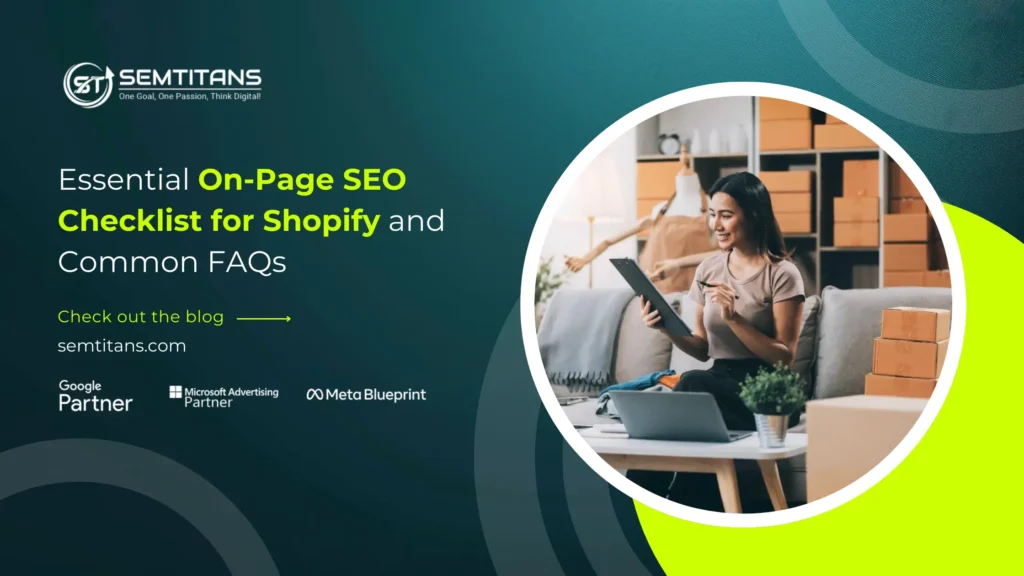
Thank you for joining us again in our Shopify SEO series. In our last blog, we discussed a basic SEO checklist so that you can start optimizing Shopify. Now, in this blog, we will explore the on-page SEO checklist. This will list the pointers to be worked on the website’s backend, which will help boost the site’s visibility and user-friendliness. So, let’s explore this post and related FAQs.
Table of Contents
ToggleOn-page SEO checklist
It is all about ensuring that each page on your website is fully optimized. For Shopify, this means optimizing your product pages, collection pages, and blog posts properly.
Keyword Research:
Searching for the right words is key in on-page SEO. You begin by finding the best keywords with the help of many tools, looking at factors like the number of searches and competition. It’s important to focus on the words your users would probably use and understand their search intent. Once you have your keywords, map them to different types of content on your site, such as informational search queries for blog posts, keywords linked to purchase-related product pages, and so on. This strategy ensures each webpage ranks well for relevant terms, with the primary and secondary keywords to back it up.
Title Tags:
These are essential for SEO because they appear in search engine results and browser tabs. They help search engines understand the content of your page and encourage users to click on your link. It’s important to include relevant keywords that users might search for and within a 50-60-character limit.
Meta Descriptions:
It provides a brief summary of the page content and show up below the title tag in search results. They impact click-through rates and help users understand what the page is about. It’s great to include relevant keywords, but don’t overdo it with keyword stuffing. The description should be clear and concise, within 150-160 characters, including a call to action.
Heading Tags (H1, H2, H3):
Headings are super important for organizing your content and making it easier for people and search engines to understand what your page is all about. Make sure to use one H1 tag for your main title with your main keywords. Then, use H2 tags for your main sections and H3 tags for sub-sections. This will help keep everything organized and easy to read. Also, add secondary keywords where they make sense.
URL Structure:
Short and clear URLs help search engines and users alike. This also boosts your rank on the results page. Use relevant keywords in the URL, but keep it short. Use dashes or hyphens, not spaces or underscores, and make sure URLs clearly tell what the page content is about.
Alt Text for Images:
Alt text is used to describe images for search engines and users who are visually impaired. It also helps search engines understand the content of the images, which can improve your website’s ranking. When writing alt text, use descriptive language to accurately convey what the image is showing. If it fits, add in some relevant keywords without overdoing it. Go for short yet detailed alt text.
Product Descriptions:
Unique and well-crafted product descriptions can boost your keyword rankings and offer valuable insights to potential customers. Write new descriptions for each product to avoid duplicate content. Incorporate relevant keywords that fit naturally into your descriptions, and don’t forget to mention the key features and benefits to attract potential buyers.
Add Schema Markup:
Schema markup is structured data that assists search engines in understanding your website’s content. It can also offer rich snippets like star ratings or product prices in search results. Incorporating schema types that match your content, like Product, Review, or Breadcrumb, also helps. Google’s Structured Data Testing Tool can help you check if your markup is done right. With regular review and updates, your schema markup will keep up with any changes in your content or products.
FAQ’s
1. Why keyword research is important?
Keyword research is about finding the right words and phrases people use while searching in search engines. It’s essential as using the right keywords can boost your website’s ranking in search results, making it easy for users to discover your content.
2. Why title tags are essential?
Headlines, also known as title tags, appear in search results. They help search engines understand what your page is about and encourage users to click on it. It’s important to have a proper short title and keyword with a character limit of 50-60.
3. What is a meta description, and how do you write it?
Think of a meta description as your webpage’s brief outline. It can be viewed below your title in search results. It is important to keep it clear and short, with 150-160 characters. Use the right keywords, and if possible, add a call to action to boost clicks.
4. What are heading tags, and how do I use them?
Heading tags like H1, H2, and H3 help organize the content and make it clear to readers and search engines. These also consist of secondary keywords. The H1 tag is used for the main title, H2 for the main section, and H3 for the subsection.
5. How should I structure my URLs?
Make sure to keep your URLs short but descriptive. They should reflect your content. It’s good to use dashes or hyphens, not spaces or underscores, and you can add keywords without making them too long.
6. What is alt text for images?
Alt text tells search engines what images are about. It also helps people with visual impairments. It’s a good practice to add context to the image and add keywords as needed.
7. Can the exact alt text be used for multiple images?
No, every image must have its own alt text that exactly describes it. This way, search engines can tell the images are different, making things easier for users’ accessibility.
8. Why are unique product descriptions important?
When writing a product description, it’s important to make it stand out, informative, and showcase the main features and benefits. Use relevant keywords, but avoid copying content from other products.
9. How to ensure that content is user-friendly?
Organize your content with clear headings, short paragraphs, and bullet points. This will make reading and navigating easier for users and search engines.
10. What is schema markup, and how does it help my site?
Schema markup is a type of structured data that helps search engines understand website content. You can use schema types like “Product” or “Review” to boost search visibility with rich snippets.
11. How often should one update on-page SEO elements?
Review and update your title tags, meta descriptions, and content regularly to keep up with the latest trends, keywords, and changes in your business or offerings. Try to plan for regular checks every couple of months.
Wrapping Up
Knowing what on-page checklist must be followed while optimizing the website is important. This includes keyword research, title tags, meta descriptions, heading tags, URL structure, alt text, product descriptions, and schema markup. Monitoring and optimizing these elements can improve SEO and increase brand visibility.












